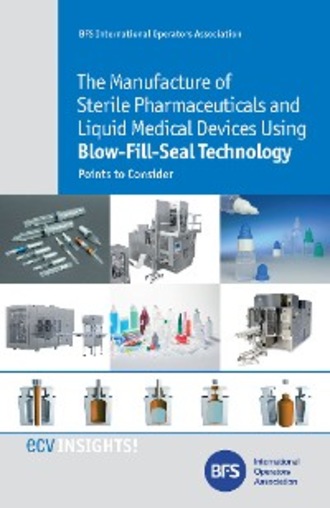
Полная версия
The Manufacture of Sterile Pharmaceuticals and Liquid Medical Devices Using Blow-Fill-Seal Technology

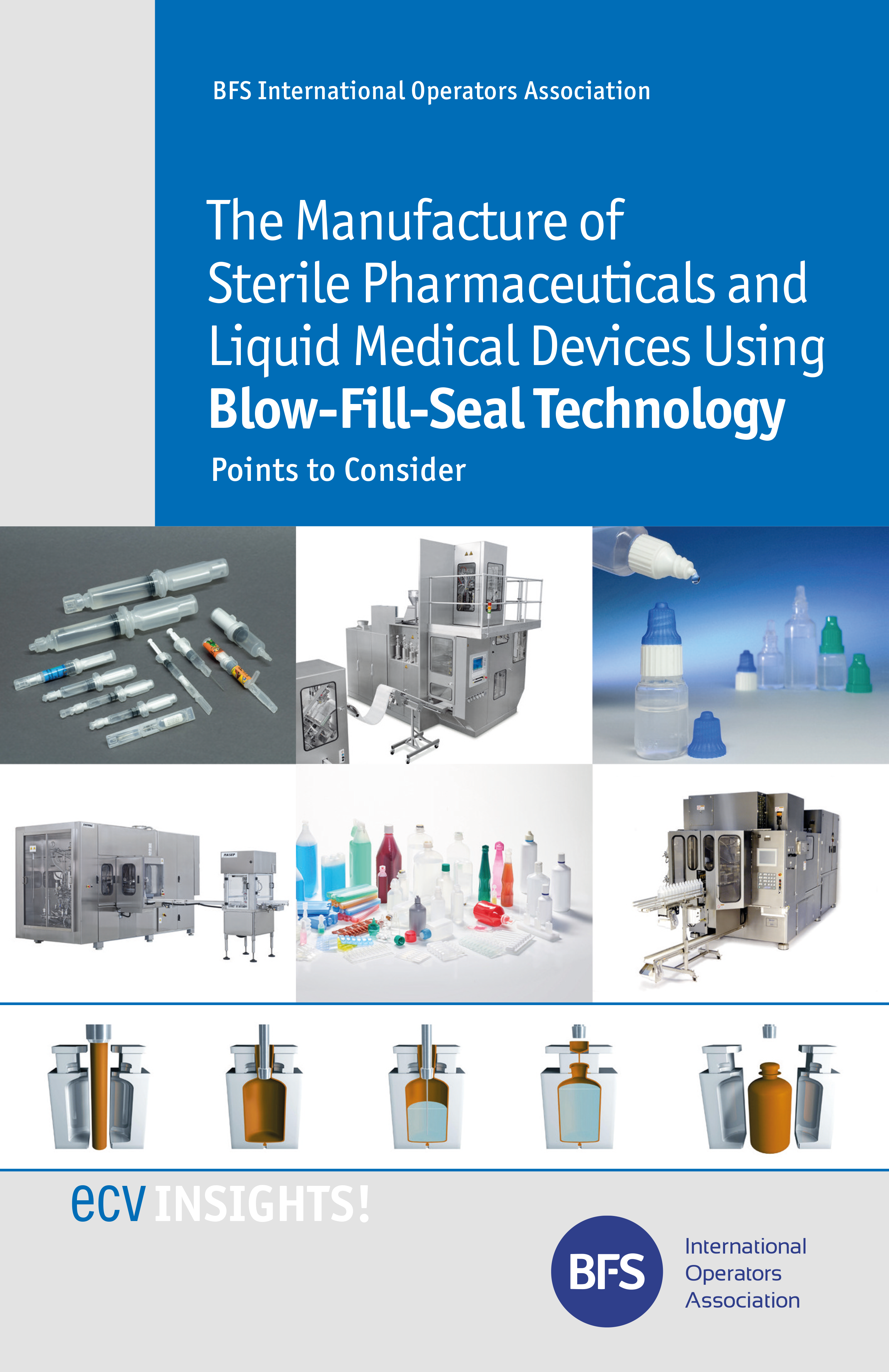

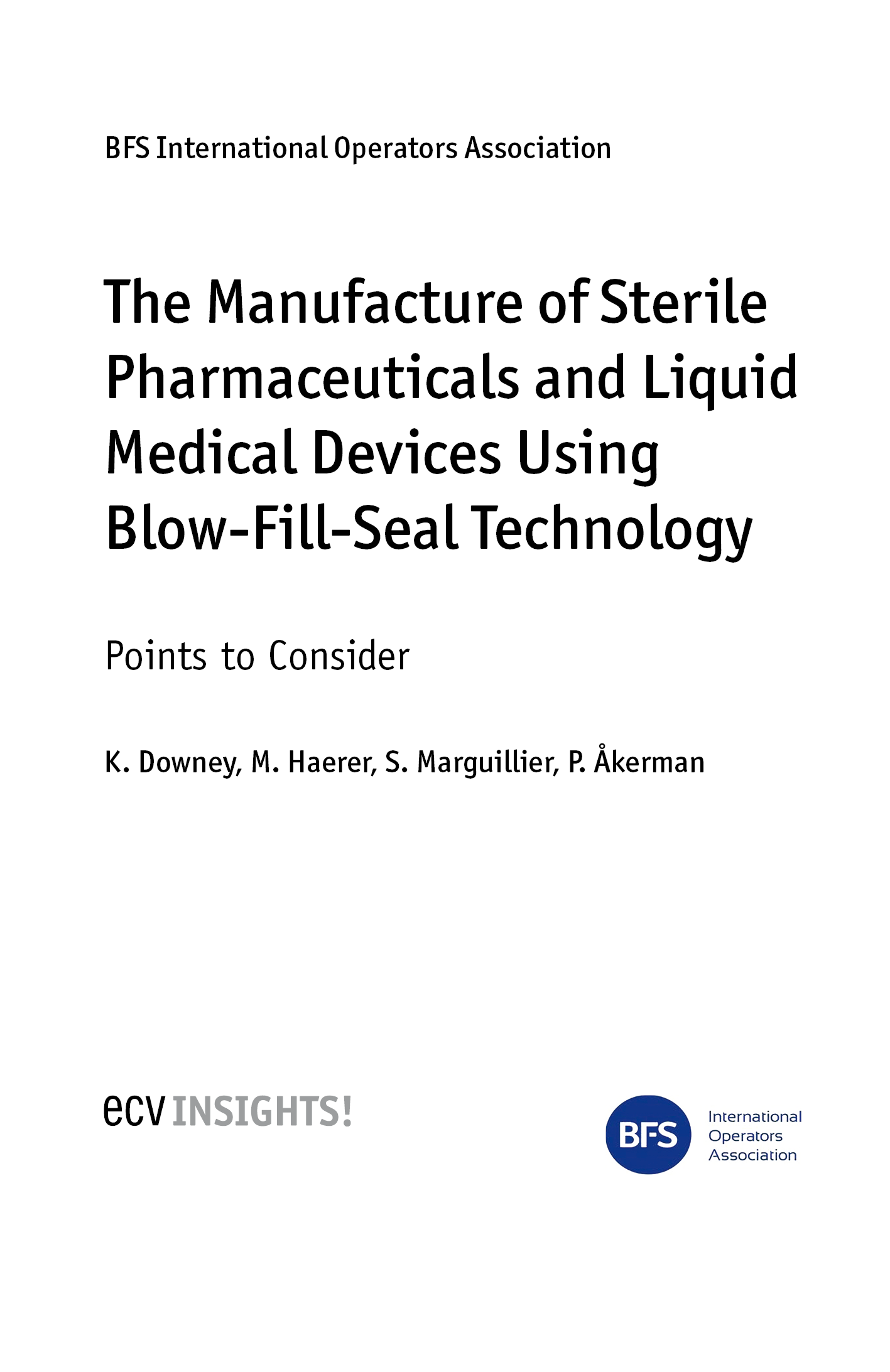
Former editions:
1st edition September 1993 by S. Probert, S. Forrester-Coles
1st main revision September 1998 (general update)
2nd main revision October 2002 (general update) by A. Löfgren
small revision January 2003(small revision/update of integrity testing sections) by A. Löfgren
3rd main revision April 2007 (update in general and regarding the revised FDA guidance)
by E. Dewhurst
4th main revision Nov. 2011/March 2012 (general update, Media Fills, SIP, implementation of
rotary machine type 4010) by K. Downey, M. Haerer, S. Marguiller, P. Åkerman
5th corrected version December 2016
The pictures on the front cover are sponsored by Brevetti Angela, Rommelag and Weiler Engineering.
Bibliographic data available from the German National Library
The German Library catalogs this publication in the German National Bibliography; detailed bibliographic information can be found on the internet website: http://dnb.ddb.de.
The Manufacture of Sterile Pharmaceuticals and Liquid Medical Devices Using Blow-Fill-Seal Technology: Points to Consider
ISBN 978-3-87193-443-8
© 2017 ECV · Editio Cantor Verlag für Medizin und Naturwissenschaften GmbH, Aulendorf (Germany).
All rights, in particular those of duplication, distribution, and translation are reserved by BFS International Operators Association c/o Melitek A/S, DK-4840 Nørre Alslev, and the publisher without any limit in time. No part of this publication may be reproduced, stored in a retrieval system, or transmitted in any form or by any means, electronic, mechanical, photocopying, recording, or otherwise without the prior written permission of the publisher. The absence of the symbol ® after any name does not imply that this name is not under trademark protection.
ECV · Editio Cantor Verlag on the internet www.ecv.de
Typesetting: Reemers Publishing Services GmbH, Krefeld
Printing: HOLZMANN DRUCK GMBH & CO. KG, Bad Wörishofen
Contents
Disclaimer 7
1. INTRODUCTION 9
2. OBJECTIVE 11
3. BFS PROCESS OUTLINE 12
3.1 Shuttle Type Machines 12
3.2 Rotary Filling Machines 14
3.3 Additional Applications 16
4. ADVANTAGES & CHALLENGES OF BLOW-FILL-SEAL TECHNOLOGY 18
4.1 Advantages 18
4.2 Challenges 19
5. DESIGN 21
5.1 Product Design 21
5.1.1 Aseptic processing versus terminal sterilisation 21
5.1.2 Terminal sterilisation 21
5.1.3 Polymer 22
5.1.4 Container design 23
5.1.5 Secondary packaging 24
5.2 Equipment Design 25
5.2.1 General 25
5.2.2 Control of critical zone environment 26
5.2.3 Air shower design (shuttle type machines) 27
5.2.4 Product pathway 28
5.2.5 Mould design 28
5.2.6 Deflashing 29
5.2.7 Equipment Monitoring 29
5.2.8 Container closure system leak detection 30
5.3 Facility Design 31
5.3.1 Aseptic Processing Area (APA) 31
5.3.2 Support areas 34
5.3.3 Polymer storage and distribution 34
5.3.4 Utilities 35
6. QUALIFICATION AND VALIDATION 36
6.1 PRODUCT VALIDATION 36
6.1.1 Container/Closure integrity testing 36
6.1.2 Process capability 36
6.2 Equipment Validation 37
6.2.1 Extruder 37
6.2.2 Air Flow 38
6.2.3 Clean in Place (CIP) of the product pathway 38
6.2.4 Sterilisation in Place (SIP) of the product pathway 38
6.2.5 Process simulation (media fill) for aseptic filling lines 40
6.2.6 Moulding and filling system 44
6.2.7 Downstream process 44
6.2.8 Controls 44
6.2.9 Filtration 45
6.3 Facility Validation 45
7. OPERATION 46
7.1 Process Operation 46
7.1.1 In-process controls 46
7.1.2 Start-up procedures 47
7.1.3 Interventions 47
7.1.4 Environmental monitoring 48
7.2 Equipment Operation 51
7.2.1 Sanitisation of “critical” surfaces 51
7.2.2 Equipment cleaning 51
7.2.3 Cooling systems 51
7.2.4 Extruder control 51
7.2.5 Maintenance 52
7.3 Facility Operation 52
7.3.1 Gowning 52
7.3.2 Polymer handling 53
7.3.3 Use of regrind polymer material 53
7.3.4 Training 53
8. RISK ASSESSMENT 55
8.1 Product contamination 55
8.2 Other product quality attributes 57
APPENDIX 59
GLOSSARY 60
GUIDANCE REFERENCES 62
GENERAL REFERENCES 63
Disclaimer
This document was produced and is disseminated by the Pharmaceutical Blow-Fill-Seal International Operators Association (the “Association”) as a service of the Association solely for the convenience of its members. These ‘Points to Consider’ are an effort to provide a compilation of current Blow-Fill-Seal (“BFS”) manufacturing operations and practices. In producing this document, the Association has attempted to reflect accurately the current state of BFS manufacturing operations on a worldwide basis. However, the Association makes no claim whatsoever regarding these ‘Points to Consider’ to any user of these ‘Points to Consider’, including without limitation, any claim that the document:
– contains no errors
– covers all actual or potential aspects of BFS operations
– is in all instances completely up to date in its description or outline of current practice
– represent the unanimous [or consensus] opinion of the BFS industry or the Association members
– reflects the requirements of all applicable laws
All use of these ‘Points to Consider’ shall be at the user’s sole risk.
This document, and the procedures contained in the ‘Points to Consider’, has not been reviewed by, nor have they been endorsed by, filed or registered with, any governmental agency having jurisdiction over these matters. This document do not create any rights for, or confer any rights upon, any person, nor do they operate to bind the international and national authorities (FDA, European Commission, any other federal, state or local regulatory agency), or the public, in any manner. Where these ‘Points to Consider’ reiterate a requirement imposed by statute or regulation, the requirement’s having the force and effect of law is not changed or affected in any way by virtue of its inclusion in this document, nor does such inclusion give these ‘Points to Consider’ the force of law.
The mention in this document of commercial products, their sources, or their use in connection with matters described in the ‘Points to Consider’ is not, and is not to be construed as, either an actual or implied endorsement of such products by the Association.
The Association shall not be liable for, and disclaims all liability for, any and all losses, costs or damages, however arising, whether direct or indirect, incidental, consequential, punitive or exemplary, incurred as a result of or in connection with any person’s following, or failing to follow, these ‘Points to Consider’.
The BFS process is a technical one and appropriate and adequately trained expert personnel must be employed at each stage of the BFS process.
1. INTRODUCTION
Blow-Fill-Seal (BFS) technology has been used for pharmaceutical and liquid medical device manufacturing since the 1970s. This processing technology has become accepted worldwide for both aseptic and terminally sterilised liquid products and is currently used in more than 50 countries throughout the world.
BFS technology lacks harmonisation and specific standards on a worldwide basis. As a result, the technology has developed in an isolated fashion, with each company and each regulatory agency establishing its own interpretation of acceptable BFS practice.
In 1989, the Pharmaceutical Blow-Fill-Seal International Operators Association (BFS IOA) was established as an interest group of pharmaceutical and associated companies actively involved with BFS processing. The Association was formed to provide its members with an opportunity to exchange ideas and opinions, and to formulate agreement on operating standards. It also provides a forum to speak with a unified voice to machine manufacturers, commercial suppliers, and regulatory bodies. The Association has expanded worldwide and now has over 60 member companies.
In an attempt to establish a common understanding of acceptable practice in BFS processing, the Association first published a “Points to Consider for Pharmaceutical Blow-Fill-Seal Manufacturing Operations” (PTC) document in September 1993. The document addressed points specific to BFS processing but also covered many more general areas. The current PTC document focuses on issues specific or unique to BFS technology and has undergone periodic review and systematic updates since its inception.
This document is the culmination of several reviews during 2010 and 2011 and the most current version is from March 2012.
The document is structured into 3 main sections covering design, start-up/validation, and routine operation. Within each section, Product, Equipment and Facility are considered.
DesignInitial start-upRoutine operationProduct








2. OBJECTIVE
The objective of the ‘Points to Consider’ document is to provide recommendations specific to the operation of Blow-Fill-Seal technology for the manufacture of sterile pharmaceuticals and liquid medical devices. The principles of BFS technology as applied to filling are considered to be the same in terms of machine process for both aseptically filled and terminally sterilised products.
This document provides information to supplement and to assist with interpretation of international standards and regulatory guidance from the perspective of BFS operations, and considers specific aspects of BFS operation which are not covered by existing published information.
The PTC is intended as a guide for industry and is not meant to supplant or duplicate any existing regulatory guidance. A list of current regulatory guidance references is provided in the Appendix.
3. BFS PROCESS OUTLINE
Blow-Fill-Seal technology is a pharmaceutical filling process in which containers are formed from a thermoplastic granulate, filled with product and then sealed in a continuous, integrated, automatic operation. Originally developed for use in other industries, BFS technology has been adapted for use in the manufacture of sterile pharmaceutical, medical device, biological, and veterinary products. The two most common types of BFS machines are the shuttling machine (with parison cut) and the rotary machine (closed parison) types. Both are considered in this document.
In the process, bulk solution/suspension is delivered to the filling machine, through the filling system to the filling needles (“mandrels”).
Polymer granules are extruded under pressure (up to 350 bar) as a hot (approx. 180°C) mouldable plastic tube (“parison”) or set of parisons.
3.1 Shuttle Type Machines
A downward flow of sterile filtered air is passed through the parison (parison support air) to prevent collapse of the molten tube. The 2 halves of a mould close around the parison(s) to form the body of the container(s). Simultaneously, the newly formed container in the mould is cut free from the parison by a “knife”.
The mould is transferred to the filling position.
The filling mandrel is lowered into the plastic tube and the container is shaped either by vacuum or with sterile blowing air or other inert gas supplied by the mandrel. Subsequently, the container is filled with the required volume of the product. During the liquid fill, headspace gas is displaced from within the container, either through the mandrel or direct to room atmosphere, depending on the container configuration.
The filling mandrel is then raised and the containers are sealed automatically by forming the still hot plastic above the main mould, by closing the upper section of the mould, (head/seal mould). The entire mould assembly then opens, releasing the filled container(s) that have been formed, filled and sealed.
This complete cycle generally takes between 10–20 seconds depending on container design and volume of fill. Parison extrusion continues, as the mould returns to the first station, and the cycle repeats (Fig. 1).
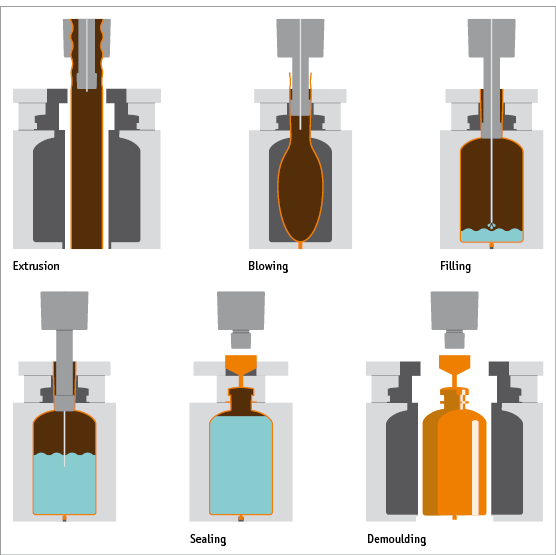
Fig. 1 Schematic representation of the open parison Blow-Fill-Seal process.
3.2 Rotary Filling Machines
There are a number of significant differences between shuttling zone machines and rotary filling machines:
● Rather than 1 or 2 sets of moulds, there are typically 15 sets located on 2 rotating chains.
● The units are produced in 1 continuous ribbon. This means that there is no ‘shuttling zone’ or knife cut required for machines of this type. As a result, particle generation is generally reduced and the units are not open to the environment at any point during the process (Fig. 2a and 2b).

Fig. 2a Schematic representation of the closed parison Blow-Fill-Seal process.
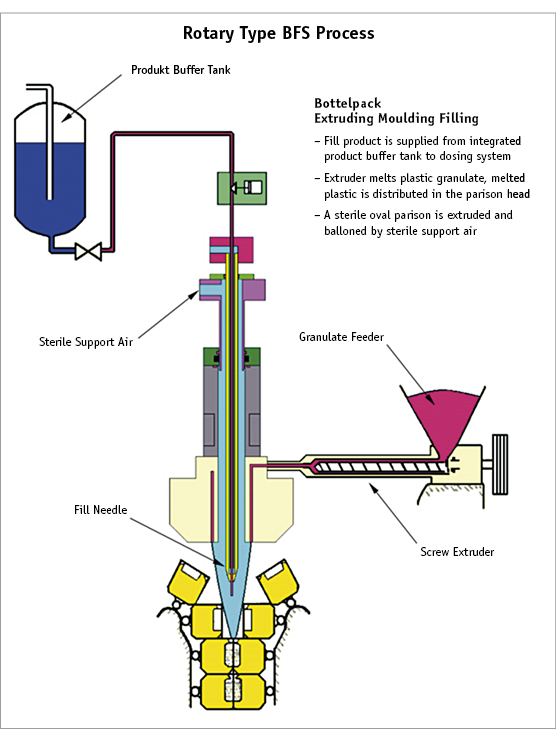
Fig. 2b Schematic representation of the closed parison Blow-Fill-Seal process.
● There is no traditional air shower as seen on ‘open parison’ machines. When not filling, the filling tips are retracted and reside completely within the extruder head and are flushed with sterile air. During filling, the filling tips are completely enclosed by the continuously extruding parison, which is sealed at the bottom by the continuous formation of the units. Throughout the whole time, the tips are surrounded by sterile air. Any loss of pressure inside the parison or not enough air entering into the parison will lead to a too small parison width. This will lead to filling being suspended and the needles will retract into the parison head. The sterility of the tips can therefore be maintained.
● Due to there being no traditional air shower, and the filling tips being completely enclosed within the parison, it is not possible to perform continuous viable and non-viable particle monitoring throughout the batch. Therefore, it is not possible to classify this area as Grade A in the same manner as for shuttling machines. Any particle monitoring device placed within the closed parison may interfere with the velocity and direction of the sterile air. This may cause the parison to collapse onto the filling tips. Once extrusion is stopped at the end of batch, the filling environment ceases to exist. Therefore, any air samples taken of the air leaving the parison head will not provide meaningful data.
Note
It can be argued that the sterile environment in which the filling tips are present during filling is actually the same as within the sealed, filled unit. Demonstrating that the filling environment is of the appropriate quality therefore requires consideration of the entire sterility assurance ‘package’ for the batch/process, i.e. monitoring of critical parameters/alarms during each batch, parison support filter integrity tests at the end of each batch, media fills, extruder validation, bioburden of incoming polymer etc.
● No operator intervention is possible within the sterile environment once the parison is formed.
3.3 Additional Applications
The majority of BFS machines operate as described above, although there are variations on the principle. Certain machines can insert devices before container closure, e.g. syringes, rubber stoppers, and eye droppers. It is important to consider that any device to be inserted during the blow-fill-seal process must be appropriately sterilised and handled to ensure its sterility is maintained.
In addition, some machines also have co-extrusion capabilities, which can provide an additional barrier to oxygen and/or volatiles migration into the final container. It can also provide an additional barrier to reduce water loss out of the final container. A typical co-extrusion machine has 5 extruders (Fig. 3).

Fig. 3 Schematic representation of the co-extrusion process.
4. ADVANTAGES & CHALLENGES OF BLOW-FILL-SEAL TECHNOLOGY
4.1 Advantages
Blow-Fill-Seal technology offers 2 highly significant advantages over “traditional” aseptic filling operations.
1. In BFS operations, personnel should not normally be present in the filling area during the filling process, thereby removing the greatest potential source of microbial contamination from the operation.
2a. For shuttling machines, the containers are formed immediately before filling, are filled under controlled conditions, and are sealed immediately after filling. Therefore, the exposure time to the environment for any individual product units is only a few seconds.
Конец ознакомительного фрагмента.
Текст предоставлен ООО «ЛитРес».
Прочитайте эту книгу целиком, купив полную легальную версию на ЛитРес.
Безопасно оплатить книгу можно банковской картой Visa, MasterCard, Maestro, со счета мобильного телефона, с платежного терминала, в салоне МТС или Связной, через PayPal, WebMoney, Яндекс.Деньги, QIWI Кошелек, бонусными картами или другим удобным Вам способом.



